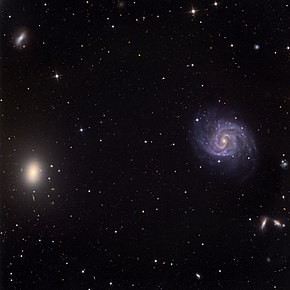NGC 1052
Appearance
| NGC 1052 | |
|---|---|
 NGC 1052 (lower left) imaged with a 32-inch telescope | |
| Observation data (J2000 epoch) | |
| Constellation | Cetus |
| Right ascension | 02h 41.1m [1] |
| Declination | −8° 15′ 21″[1] |
| Apparent magnitude (V) | 12.1[1] |
| Characteristics | |
| Type | E4[1] |
| Apparent size (V) | 3.0′ × 2.1′[1] |
NGC 1052 is an elliptical galaxy in the constellation Cetus.
Features
NGC 1052 is located at a distance of around 63 million light years from the Milky Way,[2] and has a LINER-type active galactic nucleus which signals the intense starburst activity in the galaxy's center[3] that were confirmed with observations with better resolution showing a number of star-forming regions and young star clusters.[4]
NGC 1052 shows also two small jets emerging from its nucleus as well as a very extended disc of neutral hydrogen, far larger than the galaxy itself,[5] all these features suggesting a gas-rich galaxy collided and merged with it 1 billion years ago producing all the above features.[4]
References
- ^ a b c d e "NASA/IPAC Extragalactic Database". Results for NGC 1052. Retrieved 2013-12-21.
- ^ J. L. Tonry; A. Dressler; J. P. Blakeslee; E. A. Ajhar; et al. (2001). "The SBF Survey of Galaxy Distances. IV. SBF Magnitudes, Colors, and Distances". Astrophysical Journal. 546 (2): 681–693. Bibcode:2001ApJ...546..681T. doi:10.1086/318301.
- ^ Michael Pierce; Jean P. Brodie; Duncan A. Forbes; Michael A. Beasley; et al. (2005). "The Evolutionary History of the Elliptical Galaxy NGC 1052". Monthly Notices of the Royal Astronomical Society. 358 (1): 419–431. Bibcode:2005MNRAS.358..419P. doi:10.1111/j.1365-2966.2005.08778.x.
- ^ a b Fernández-Ontiveros, J. A.; López-Sanjuan, C.; Montes, M.; Prieto, M. A.; et al. (2011). "The most recent burst of star formation in the massive elliptical galaxy NGC 1052". Monthly Notices of the Royal Astronomical Society Letters. 411 (1): L21–L25. Bibcode:2010MNRAS.tmpL.179F. doi:10.1111/j.1745-3933.2010.00985.x.
- ^ Notes for NGC 1052 (NED)
